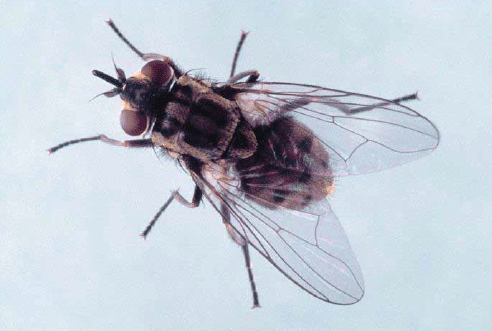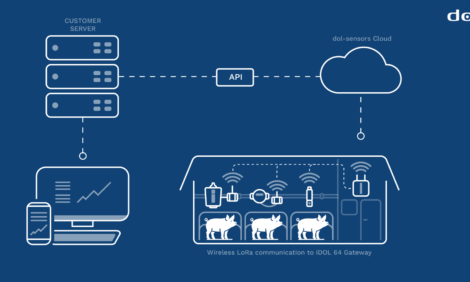



Stable Fly (Dog Fly) Control
The biology and control of flies are outlined by P.E. Kaufman (associate professor/Extension entomologist) and E.N.I. Weeks (assistant research scientist) in the Entomology and Nematology Department of the Cooperative Extension Service at the University of Florida.Introduction
The stable fly (Figure 1) is a blood-sucking filth fly of
considerable importance to people, pets, livestock and the
tourist industry in Florida. Filth flies, including stable flies,
exploit habitats and food sources created by human activities,
such as farming.
'Stable fly' is just one of the many
common names used to refer to this pest. Stable flies are
also known as 'dog flies' because the fly often bites and irritates
dogs. Other names are 'lawn mower fly', because the
larvae are often found in the cut grass on the undersides of
lawn mowers, and the 'biting house fly'.
Stable flies primarily
attack animals for a blood meal, but in the absence of an
animal host, they will bite people.

In its normal environment, the stable fly is not considered a pest to humans. However, certain regions of the United States have considerable problems with large numbers of stable flies attacking people. The coastal part of New Jersey, the shores of Lake Superior and Lake Michigan, some Tennessee Valley Authority lakes, and most importantly due to the significance of the tourism industry in these areas, west Florida and along the Gulf coast to Louisiana, are areas that historically have severe stable fly problems. Although west Florida has the most severe stable fly problems, the flies are numerous throughout the state.
Biology
Stable flies breed in soggy hay, grasses or feed; piles of
moist, fermenting weed or grass cuttings; spilled green
chop; peanut litter; seaweed deposits along beaches; soiled
straw bedding; and sometimes in hay ring feeding sites
when the temperatures warm in the spring.
The female,
when depositing eggs, will often crawl into loose material.
Each female fly may lay 500 to 600 eggs in four separate
batches. Eggs are small, white, and sausage-shaped. Eggs
hatch in two to five days into larvae, which feed and mature in
14 to 26 days. Larvae are typical maggots and transform to
small, reddish-brown, capsule-like pupae from which the
adult flies emerge. The average life cycle is 28 days, ranging
from 22 to 58 days, depending on the weather conditions.
In Florida, during years with wet summers, the stable fly
breeds throughout the year, although peak populations
occur from October through January.
The stable fly adult is similar to the house fly in size and
color. Adult stable flies are typically 5mm to 7mm in length and
unlike the house fly, which has an unpatterned abdomen,
stable fly abdomens have seven circular spots. Stable flies
also have long, bayonet-like mouthparts for sucking blood.
Unlike many other blood feeding fly species, both male and
female stable flies feed on blood. Stable flies feed mainly on
the legs of cattle and horses.
Stable flies are competent fliers and have been shown to
disperse far from their breeding sites to feed. Recent studies
in Florida have shown that the majority of stable flies
collected at equine facilities were travelling between 0.8km
and 1.5km from cattle farms, following a blood meal, to
breed in equine farms. One study even recorded stable flies
travelling distances of up to 70 miles from their breeding
sites. They are inactive at night, resting on fences, buildings,
trees and bushes.
Scope of the Problem in Florida
Stable flies attack people, pets and agricultural animals
throughout Florida. Stable fly bites are extremely painful
to both people and animals. When hungry, stable flies are
quite persistent and will continue to pursue a blood meal
even after being swatted several times. Although the bite is
painful, there is little irritation after the bite, and few people
exhibit allergic reactions.
The tourist industry is severely affected by large numbers
of stable flies especially in west Florida, from Wakulla
County to Escambia County. Because stable flies are active
during the daylight hours, the flies have a big impact on
Florida's beach tourism. When stable flies are numerous,
tourists leave and are unlikely to return if their vacation was
spoiled.
Stable flies congregate on beaches because they are sensitive
to the wind. When a northerly wind blows toward
the beach from inland, the flies are carried to the beach
and take shelter from the wind on the leeward side of the
dunes. Some individuals even fly to boats and are taken off
shore, where they continue to bite.
The flies normally do
not concentrate in residential areas, but they may bite an
occasional human and often bite dogs as they pass through
the dunes on the way to the beach. Stable flies are usually
on the beach during the morning hours, when the wind is
from the north. Frequently, during the middle of the day,
the thermal currents on land pull the winds in from the
Gulf and the flies suddenly leave. They may then move
inland 10 to 15 miles from the Gulf of Mexico.
The animal industries of Florida are severely affected by
the stable fly. Because the fly takes blood meals, animals are
weakened from blood loss and continual irritation. Animals
such as swine, cattle and horses show reduced weight
gains. As a result of stable fly annoyance, animals stamp
nervously, switch, become irritable and have been known
to stand in water, with only their necks and heads exposed,
to escape the biting flies during heavy outbreaks.
Stable flies also are known to transmit the pathogens that cause
diseases such as anthrax, equine infectious anemia (EIA),
and anaplasmosis to animals. In addition, bite wounds can
be sites for secondary infection.
Because these pests leave an animal immediately after feeding,
they may go unnoticed unless heavy outbreaks occur.
Monitoring is important for early detection of a potential
outbreak situation and is usually done by counting flies
on lower legs of cattle and horses. Counts should be done
on all four legs of at least 15 animals. Greater than 10 flies
per animal is considered economically damaging.
High
numbers of stable flies on animals suggests a productive
local breeding site. However, it is important to note that
the absence of a local breeding site does not necessarily
mean that the animals are not being bothered by stable
flies. Because stable flies will disperse from breeding sites
and travel great distances to obtain a blood meal, breeding
sites may be over 1km away. Consequently, a stable
fly breeding site on your property may have an influence
on the people and animals for miles around.
A study of
equine facilities in Florida found that only 24.3 per cent of the
flies captured on horse farms had fed on horses; 64.6 per cent had
travelled up to 1.5km from cattle farms to reach the horse
farms, with 9.5 per cent of these having fed on humans.
While one stable fly does not cause significant damage,
50 to 100 of these blood-sucking pests occurring together
with 500 horn flies can cause a substantial daily loss of
blood. This common livestock pest situation can result in a
loss of 10 to 20 per cent in milk production and up to 40 pounds of
beef gain eliminated per animal each year — an economic
loss of millions of dollars per year to Florida cattlemen.
Recent estimates give a total impact to the US cattle
industry of $2.211 billion per year, with $360 million for
dairy, $358 million for calf-cattle herds, $1.268 billion for
pastured cattle and $226 million for cattle on feed.
Control at Breeding Sites
The most practical and economical method for reducing
stable fly populations is the elimination or appropriate
management of breeding sources. It is important to
remember that flies cannot develop in dry materials.
Furthermore, due to the dispersal capability of stable flies,
breeding sites on your property may be causing problems
for other animals that may be miles away or in residential
areas where the flies feed on humans and pets. Management
of potential breeding sites should be completed for the
health and safety of your animals, your neighbours' animals,
and the local community. Most of the following methods
also will reduce the presence of other localised fly problems
through improved sanitation and hygiene.
Stable flies breed in the following types of material:
- Green chop or silage - Stable fly maggots thrive in decaying
plant material, such as old silage in and around feed
troughs and trench silos. Silage probably has a greater
potential for producing stable flies than almost any other
material found on today’s farms. More than 3,000 stable
fly maggots per cubic foot of silage have been found in
mid-January on some west Florida farms, and five times
that number in late summer.
- Crop residues - Unwanted crop residues, such as peanut
vines discarded in piles during harvest, are frequently
important sources of fly breeding. To avoid creating a
breeding site, this material should be spread thinly for
quick drying.
- Hay and grain - Hay allowed to accumulate where
animals are fed in fields decays rapidly when exposed
to the elements and may produce flies in tremendous
numbers. To prevent this source of fly breeding, feed
cattle at a different place in the field each time so that
accumulations of old hay do not occur. Likewise, spilled
grain around feed troughs or storage bins may provide
the stable fly with a moist, favorable breeding medium
and should be cleaned up immediately.
- Animal manures - When handled properly, manure
need not breed stable flies at all. lt should not be allowed
to accumulate for more than a week before it is spread
thinly on fields, where quick drying eliminates stable fly
breeding.
- Stables - The popularity of pleasure horses creates a
staggering number of fly breeding sources. However,
proper care and management of waste feed and manure
can greatly reduce or eliminate fly populations in these
areas. Stalls should be cleaned of droppings daily and the
manure spread thinly (not more than 1–2 inches deep).
The choice of bedding is very important. Hay or straw
absorbs urine and decomposes rapidly, and unless it is
changed every few days, it will produce thousands of flies. A far better material is wood shavings, which, when
cleaned of manure daily and changed approximately
every two weeks, will not normally breed flies.
- Other sources - Any pile of moist, decaying organic matter should be considered a potential source of stable flies that could cause serious harm to livestock.
Improving Control
Great progress has been made in control of stable flies in recent years, but a number of actions must be taken if the present level of control is to be improved significantly. These are:
- The public and those responsible for stable fly control
must be made aware of the extent of the problem and
must realize that it cannot be controlled by small-scale,
isolated efforts.
- There must be realistic funding for trained personnel
and equipment to combat the pest. Because of its long
flight range, the stable fly is not a problem just at the
county level; it is a state-wide issue. Therefore, even if the
breeding of this pest is controlled in a county, there still
might be a stable fly problem in that area if the fly is not
controlled in other neighboring counties.
- Man-made sources of flies in agricultural and industrial
areas and on private premises must be eliminated or
greatly reduced. In most instances this can be accomplished
by proper handling and disposal of animal and
plant wastes.
- Each coastal county must operate an effective stable fly surveillance and control program on beaches seven days a week in late summer and fall.
References
Broce, A.B. 1988. An improved Alsynite trap for stable flies
Stomoxys calcitrans (Diptera: Muscidae). J. Med. Entomol., 25: 406–409.
Campbell, J.B., S.R. Skoda, D.R. Berkebile, D.J. Boxler,
G.D. Thomas, D.C. Adams and R. Davis. 2001. Effects of
stable flies (Diptera: Muscidae) on weight gains of grazing
yearling cattle. J. Econ. Entomol., 94:780–783.
Catangui, M.A., J.B. Campbell, G.D. Thomas and D.J.
Boxler. 1995. Average daily gains of Brahman-crossbred
and English × exotic feeder heifers during long-term
exposure to stable flies (Diptera: Muscidae). J. Econ.
Entomol., 88:1349–1352.
Catangui, M.A., J.B. Campbell, G.D. Thomas and D.J. Boxler. 1997. Calculating economic injury levels for
stable flies (Diptera: Muscidae) on feeder heifers. J. Econ.
Entomol., 90:6–10.
Cilek, J.E. 2002. Attractiveness of beach ball decoys to adult
Stomoxys calcitrans (Diptera: Muscidae). J. Med. Entomol., 39:127–129.
Hogsette, J.A. and J.P. Ruff. 1985. Stable fly (Diptera:
Muscidae) migration in northwest Florida. Environ.
Entomol., 14:170–175.
Hogsette, J.A. 1990. Comparative attraction of four
different fiberglass traps to various age and sex classes of
stable fly (Diptera: Muscidae) adults. J. Econ. Entomol., 83:883–886.
Jones, C.J., J.A. Hogsette, R.S. Patterson, D.E. Milne, G.D.
Propp, J.F. Milio, L.G. Rickard and J.P. Ruff. 1991. Origin
of stable flies (Diptera: Muscidae) on west Florida beaches:
Electrophoretic analysis of dispersal. J. Med. Entomol., 28:787–795.
Marcon, P.C.R.G., G.D. Thomas, B.D. Siegfried and J.B. Campbell. 1997. Susceptibility of stable flies (Diptera:
Muscidae) from southeastern Nebraska beef cattle feedlots
to selected insecticides and comparison of 3 bioassay
techniques. J. Econ. Entomol., 90:293–298.
Moon, R.D. 2002. Muscoid flies (Muscidae), In
G.R. Mullen and L.A. Durden (eds.), Medical and Veterinary
Entomology, vol. 2. Elsevier, San Diego, CA. pp45–65.
Pickens, L.G., E.T. Schmidtmann and R.W. Miller.
1994. How to control house and stable flies without using
pesticides, pp1–14. USDA, Washington, DC.
Pitzer, J.B., P.E. Kaufman, S.H. TenBroeck and J.E.
Maruniak. 2011. Host blood meal identification by multiplex
polymerase chain reaction for dispersal evidence of
stable flies (Diptera: Muscidae) between livestock facilities.
J. Med. Entomol., 48:53–60.
Rochon, K., T.J. Lysyk and L.B. Selinger. 2004. Persistence
of Escherichia coli in immature house fly and stable fly (Diptera: Muscidae) in relation to larval growth and
survival. J. Med. Entomol., 41:1082–1089.
Taylor, D.B., R.D. Moon and D.R. Mark. 2012. Economic
impact of stable flies (Diptera: Muscidae) on dairy and beef
cattle production. J. Med. Entomol., 49:198–209.
Wright, R.E. 1985. Arthropod pests of beef cattle on
pastures and range land, In Livestock
Entomology. R.E. Williams, R.D. Hall, A.B. Broce and P.J. Scholl (eds.). Wiley, New York. pp191–206.
October 2012






